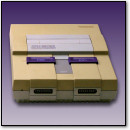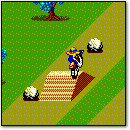[ Retro Scan of the Week ] Where’s the Bits?
Monday, June 30th, 2008 Fabulous secret powers were revealed to me the day I held aloft my magic computer….
Fabulous secret powers were revealed to me the day I held aloft my magic computer….
The tiny computer you see above originated in the UK as the Sinclair ZX81, a wildly successful build-it-yourself kit computer. Due to strong sales, Timex struck a deal with Sinclair to market a fully assembled version of the ZX81 in the United States. They rechristened the unit “Timex-Sinclair 1000,” and the minuscule wedge became the first PC to sell for under $100 (US) fully assembled.
The diminutive, Z80-based 1000 was severely limited in function by its tiny membrane keyboard, its black & white display, no sound capabilities, and only 2K RAM. Despite that, it sold well in the US thanks to an incredibly low price. These days, Timex-Sinclair 1000s are relatively easy to find, and thanks to their nice shape, they make great doorstops.
Discussion topic of the week: What’s the cheapest computer you’ve ever bought?
If you use this image on your site, please support “Retro Scan of the Week” by giving us obvious credit for the original scan and entry. Thanks.





 What’s going on here, and how did it get that way?
What’s going on here, and how did it get that way?








